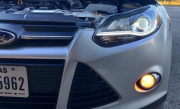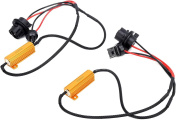
Halogen headlights are a type of headlight that uses a gas-filled bulb to produce light. They are one of the most common types of headlights, and they have been used in cars for many years.
How does halogen technology work?
Halogen headlights work by using a gas-filled bulb to produce light. The gas in the bulb is heated by an electrical current, and this produces a bright light. Halogen headlights are very efficient, and they produce a lot of light for their size.

Halogen headlights are usually made of glass, and they have a small filament inside. The filament is heated by an electrical current, and this produces light. Halogen headlights are very efficient, and they produce a lot of light for their size.
There are many benefits to using halogen headlights. They are very efficient, and they produce a lot of light. Halogen headlights also last a long time, and they are very easy to replace. However, the main drawback of halogen headlights is that they can be quite hot. This can make them uncomfortable to use in some situations, and it can also cause the headlights to break down over time.
Can you touch halogen headlights?
It's a good idea to avoid touching the glass on halogen light bulbs, even when changing the bulb. This is due to the fact that when you touch a halogen light bulb, you leave behind a residue on the light bulb that can eventually cause it to heat unevenly and shatter as a result. Drivers should instead handle the light bulb by its metal base.
There are some cases when you may need to touch the glass of a halogen headlight. If your headlight is cracked or damaged, you'll need to replace it. In this case, you can carefully remove the old headlight and install a new one. Be sure to wear gloves when doing this, and avoid touching the glass as much as possible.
How do I know if my headlights are halogen?
If you're trying to determine whether a headlight is halogen or HID, look at the beam pattern. If it's yellow, that generally means it's Halogen. On the other hand, if the light flashes for a second when turned on and then maintains its performance for about 7-10 seconds (it will also appear white), this is likely an HID headlight. Moreover, HID headlights will have a glass lens while Halogen headlights usually have a plastic lens. Another way to tell is by price; HID headlights are generally more expensive than halogen headlights.
What's the difference between regular headlights and halogen headlights?
They're different from conventional incandescent bulbs in that they contain a higher proportion of halogen gas rather than argon gas. Halogen bulbs are brighter and tend to endure longer than ordinary incandescent bulbs. Additionally, the light emitted by halogen headlights is whiter than that of regular headlights, making them more visible to oncoming traffic.
Usually, ordinary headlights have a lifespan of about 450 to 1,000 hours. In contrast, halogen headlights can last up to 2,000 hours. That said, they still require more frequent replacement than HID or LED headlights.
What is the difference between halogen and LED?
LED technology has come a long way in recent years, and is now the preferred choice for most applications. However, there are still some good reasons to choose halogen over the LED. For example, halogen bulbs are usually cheaper than LEDs. They also tend to be more durable, since they don't have any delicate internals as LEDs do. And finally, halogen bulbs produce a slightly warmer light, which some people prefer.
The light-emitting diode (LED) has a far superior bulb life expectancy. The average lifespan of halogen bulbs is 1500-2000 hours, whereas that of LEDs ranges from 30,000 to 50,000 hours. To create the same or greater illumination with an LED, less energy is required than with a halogen. The light output of LEDs is also more directional than that of a halogen. This can result in better visibility on the road, as well as a reduction in "light pollution."
If you're looking for durability, a warm light, and a cheaper option, halogen bulbs are a good choice. However, if you want the best possible bulb life expectancy and light output, LEDs are the way to go. The lifespan and energy efficiency of an LED makes it the better choice in most situations.

Can you put LED bulbs in halogen headlights?
We often get asked whether drivers can switch out their stock halogen headlight bulbs for LED or HID lights, to which we say: yes! If you're one of the millions of drivers who are tired of the dim, yellowish light output from your current headlights, then making this switch will completely brighten up your journeys.
Besides, it's not just about the light output. The lower power draw of LED and HID headlights can also mean that your car's battery will last longer. So if you're looking for a headlight upgrade that will improve both your visibility and your car's battery life, making the switch to LED or HID is a no-brainer.
Switching to LED or HID headlights is a simple process that anyone can do in their own driveway. In most cases, all you'll need is a screwdriver. You can find detailed instructions on how to do this in our article on how to install LED headlights.
Are halogen headlights legal?
The majority of maximum performance, regular, and long-life halogen bulbs are street legal. However, there are some bulbs that are not legal for use on public roads. These bulbs typically have a blue tint and produce more light than what is allowed by law.
Many states in the USA have laws that restrict the colors of light that can be emitted from a vehicle. For example, in California, only white, yellow, and amber-colored light can be emitted from the front of a car. This is why most halogen bulbs have a yellowish tint.
Usually, the type of bulb used in your car may be illegal depending on the purpose of usage. What do we mean? For instance, for headlights, you can not use off-road bulbs and for rear lights, you can not use racing bulbs. Some states tell that it is illegal to use a blue tinted headlight but it is not said anything about the license plate lights. In short, it depends on your country's or state's traffic laws about which bulbs are legal and which aren't. You should check this before you buy new halogen bulbs for your car.
While blue-tinted halogen bulbs are not legal for use on public roads, they can still be used off-road or in racing applications. If you are looking for maximum performance or want your car to look different than everyone else's, then blue-tinted halogen bulbs may be right for you. Just be sure to stay off the road with them!
How can you choose a good halogen bulb?

There are a few things you should keep in mind when choosing a halogen bulb. The wattage, or power output, of the bulb is one important factor. You'll also want to consider the color temperature of the light emitted by the bulb. And finally, make sure that the bulb you select is compatible with your car's headlight housing.
Wattage:
The wattage of a halogen bulb indicates how much power it uses. Higher wattage bulbs will produce more light, but they may also put additional strain on your car's electrical system. When choosing a bulb, be sure to select one with a wattage that is appropriate for your car.
Color Temperature:
The color temperature of a halogen bulb refers to the color of light that it emits. Bulbs with a higher color temperature will emit a blueish light, while bulbs with a lower color temperature will emit a yellowish light. You'll want to choose a bulb with a color temperature that is appropriate for your car's headlights.
Compatibility:
Not all halogen bulbs are compatible with all cars. Be sure to check the compatibility of the bulb you're considering with your car's headlight housing. Otherwise, you may end up with a bulb that doesn't fit properly and can't be used.
Light output:
The light output of a halogen bulb is measured in lumens. The higher the lumen rating, the brighter the light emitted by the bulb. When choosing a halogen bulb, be sure to select one with a high lumen rating for optimal brightness.
When choosing a halogen bulb for your car's headlights, be sure to keep wattage, color temperature, and compatibility in mind. With so many different bulbs on the market, you're sure to find one that's perfect for your car.
Final words
Halogen headlights overall are a great investment. They emit a brighter light than regular headlights, making them ideal for use in low-light conditions. And, because they're made with durable material, they'll last longer than regular headlights. Just be sure to check the legalities of using them in your state or country before you make the purchase.








